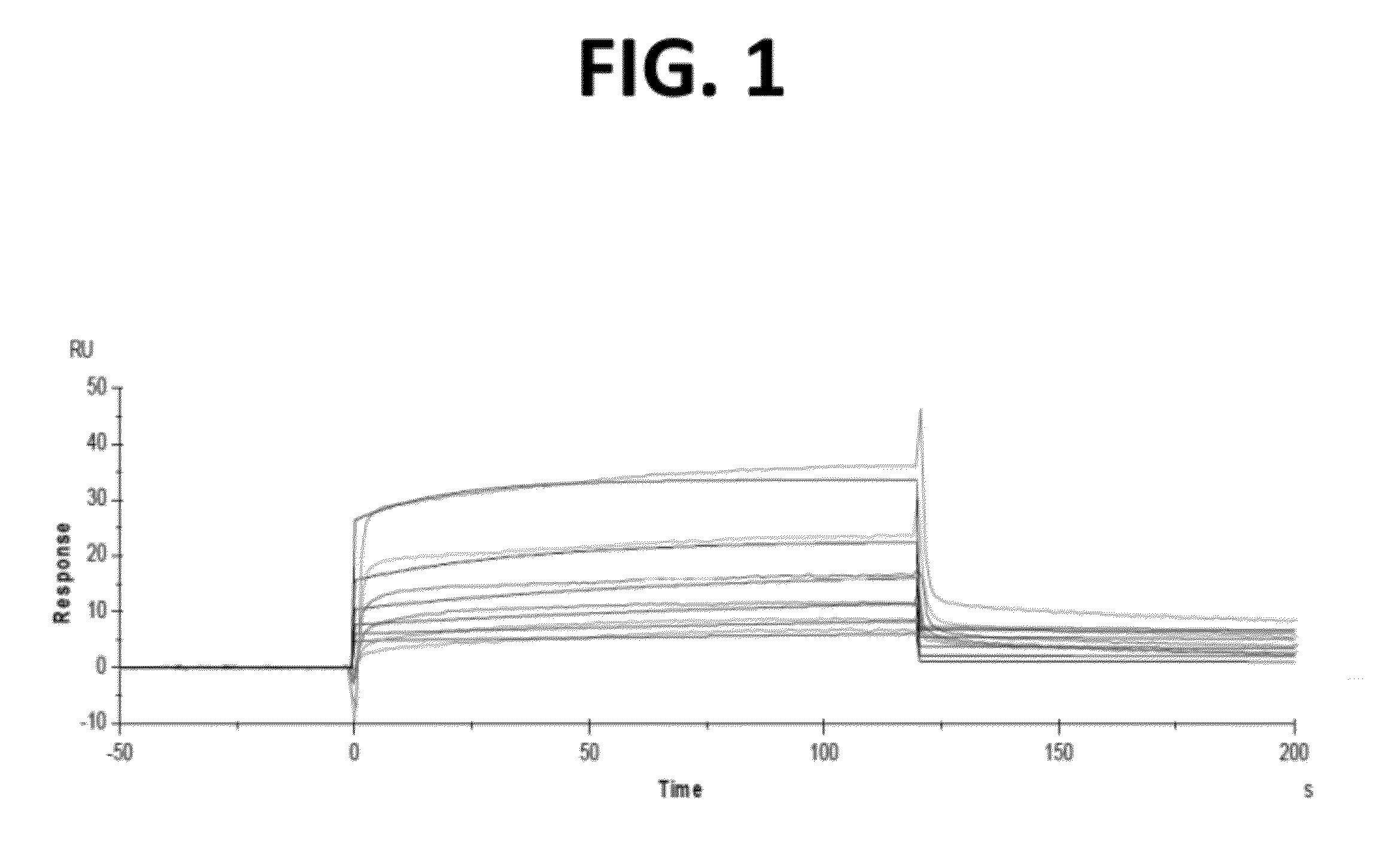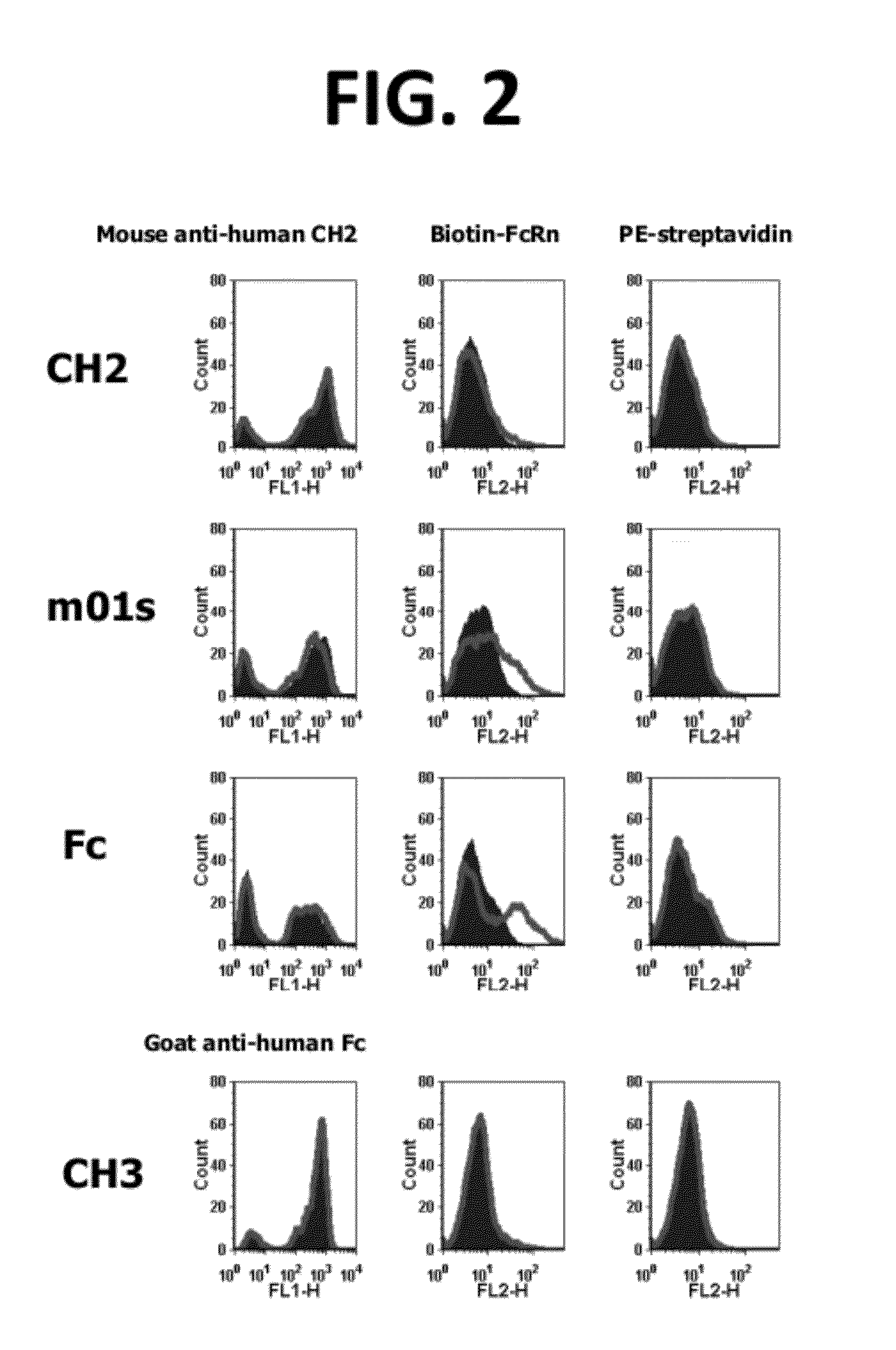CH2 Domain Template Molecules Derived From Rational Grafting Of Donor Loops Onto CH2 Scaffolds
- Summary
- Abstract
- Description
- Claims
- Application Information
AI Technical Summary
Benefits of technology
Problems solved by technology
Method used
Image
Examples
example 1
Examples of CH2 Domain Template Molecules
[0236]The following example is a list of potential CH2 domain template molecules shown in Table 5. The present invention is not limited to the examples described herein.
TABLE 5SEQ ID NO:MOL IDSEQUENCE54CT-2-2456GGPSV FLFPPKPKDT LMISRTPEVT CVVVDVSHEDPEVKFNWYVD GVEVHNAKTK PREEHNTYRVVSVLTVLH QDWLNGKEYK CKVSNKALPAPIEKTISKAK GQ55CT-2-2022GGPSV FLFPPKPKDT LMISRTPEVT CVVVDVSHEDPEVKFNWYVD GVEVHNAKTK PREEAASTYRVVSVLTVLH QDWLNGKEYK CKVSNKALPAPIEKTISKAK GQ56CT-2-1329GGPSV FLFPPKPKDT LMISRTPEVT CVVVDVSHEDPEVKFNWYVD GVEVHNAKTK PREEYDTSTYRVVSVLTVLH QDWLNGKEYK CKVSNKALPAPIEKTISKAK GQ57CT-2-1617GGPSV FLFPPKPKDT LMISRTPEVT CVVVDVSHEDPEVKFNWYVD GVEVHNAKTK PRVYPGSITYRVVSVLTVLH QDWLNGKEYK CKVSNKALPAPIEKTISKAK GQ58CT-2-1557GGPSV FLFPPKPKDT LMISRTPEVT CVVVDVSHEDPEVKFNWYVD GVEVHNAKTK PRIYWDDDKTYRVVSVLTVLH QDWLNGKEYK CKVSNKALPAPIEKTISKAK GQ59CT-2-2117GGPSV FLFPPKPKDT LMISRTPEVT CVVVDVSHEDPEVKFNWYVD GVEVHNAKTK PRISSSGDPTTYRVVSVLTVLH QDWLNGKEYK CKVSNKALPAPIEKTISKAK GQ...
example 2
Prophetic Example of Libraries Based on CH2D Template
[0237]A starting CH2D template molecule is selected from among the characterized CH2D templates, as preferably being (a) well expressed in the desired library host (E. coli in the case of phage display or in vitro display systems such as CIS or ribosomal display that employ E. coli extracts for coupled transcription-translation; yeast in the case of a yeast cell-surface display system), and (b) acceptably stable. The starting CH2D template for a subsequent library may also be selected based on having a loop structure that is more distantly related to the loop structures of any other CH2D which has previously been selected and used to derive a library, thereby accessing additional potential surface shapes with which the new library members may interact.
[0238]Based on this selected CH2D template, a series of variants are generated that differ by at least one amino acid in their sequence compared with the sequence of the starting sel...
example 3
CH2D Pharmacokinetic Study
[0241]The following example describes a single-dose pharmacokinetic study of three CH2D variants in B6 mice, hFcRn mice, and cynomolgus primates.
[0242]Three human CH2D variants were produced: (1) CH2D WT monomer (SEQ ID NO: 89); (2) CH2D WT dimer (SEQ ID NO: 90); and (3) CH2D stabilized monomer (m01s) (SEQ ID NO: 91). Briefly, proteins were produced in E. coli, purified by Ni-column affinity chromatography, endotoxin was removed and proteins suspended in PBS at pH 7.4. More specifically, the CH2D stabilized monomer (His-m01s) was expressed in E. coli. Cell paste was resuspended in 10 vol Buffer A (50 mM Tris-HCl, and 450 mM NaCl, pH 8.0) and Polymyxin B sulfate was added to suspension at 0.5 mu / ml and gently rotated for 1 h at room temperature. The resulting lysate was centrifuged at 20,000×g for 45 min. Clarified lysate was loaded on to a Ni-Sepharose column pre-equilibrated with Buffer A (2.5 ml of resin used per 1 L expression scale). The column was wash...
PUM
| Property | Measurement | Unit |
|---|---|---|
| Atomic weight | aaaaa | aaaaa |
| Length | aaaaa | aaaaa |
| Molecular weight | aaaaa | aaaaa |
Abstract
Description
Claims
Application Information
 Login to View More
Login to View More - R&D
- Intellectual Property
- Life Sciences
- Materials
- Tech Scout
- Unparalleled Data Quality
- Higher Quality Content
- 60% Fewer Hallucinations
Browse by: Latest US Patents, China's latest patents, Technical Efficacy Thesaurus, Application Domain, Technology Topic, Popular Technical Reports.
© 2025 PatSnap. All rights reserved.Legal|Privacy policy|Modern Slavery Act Transparency Statement|Sitemap|About US| Contact US: help@patsnap.com



